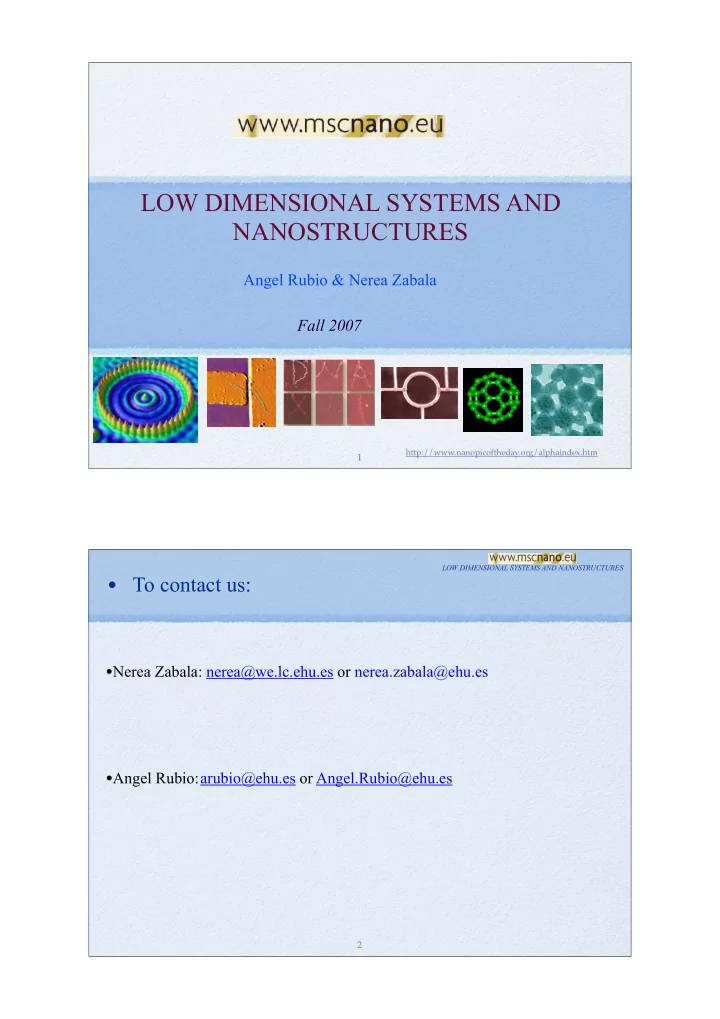

LOW DIMENSIONAL SYSTEMS AND NANOSTRUCTURES Angel Rubio & Nerea Zabala Fall 2007 http://www.nanopicoftheday.org/alphaindex.htm 1 LOW DIMENSIONAL SYSTEMS AND NANOSTRUCTURES • To contact us: • Nerea Zabala: nerea@we.lc.ehu.es or nerea.zabala@ehu.es • Angel Rubio: arubio@ehu.es or Angel.Rubio@ehu.es 2
LOW DIMENSIONAL SYSTEMS AND NANOSTRUCTURES • The aim: • This course in intended to provide a general introduction to the most important nanostructures in Nanoscience and Nanotechnology, attending to their dimensionality (2D, 1D, 0D). • The most important phenomena emerging in low dimensional systems will be described. • Finally special attention will be paid to carbon nanostructures, which exist in all dimensions (diamond, graphite, nanotubes, fullerenes...). 3 LOW DIMENSIONAL SYSTEMS AND NANOSTRUCTURES • Background: • Quantum Mechanics • Solid State Physics • Nanoscience: a historical perspective 4
• 3 ECTS Credits: • 1ECT credit=25 hours • 30% lectures • 20% exercises • 30% personal work • 20% others: short questions posed during the course, essays, bibliographic search.... 5 • The lectures: • DIPC • Wednesday, Thursday 10:00-12:00 6
• The contents: 1. Length scales and low dimensionality. 2. Electronic states and quantum confined systems. 3. 2D systems. Quantum wells, heterojunctions and artificial structures. Quantum Hall effect. 4. 1D systems. Quantum wires: quantum transport. 5. 0D systems. Quantum dots and artificial atoms: electronic (single electron tunneling and Coulomb blockade) and optical properties. Metal clusters. 6. Carbon nanostructures: fullerenes and carbon nanotubes. 7 • Calendar& program: Wednesday& Thursday 10:00-12:00 • Presentation 1) Length scales and low dimensionality. 2) Electronic states and quantum confined systems. 3)2D systems. Quantum wells, heterojunctions and artificial structures. 3 )2D systems. QH effect 4) 1D systems. Quantum wires . Quantum transport No lecture A. Rubio N. Zabala Student presentations 8
• Calendar& program: 5) 0D systems. 6) Carbon nanostructures: fullerenes and carbon nanotubes. Student No lecture presentations Test (?) A. Rubio 9 • Examination: • Exercises and participation, 30% • Short test, 40% • Monographic essay, 30% 10
• Subjects for monographic essays: • Based on a paper covering some aspect discussed briefly in the lectures. • Approximate length: less than 10 written pages. • Date: the last week (24, 30, 31 January) 11 • Material: • The material used in the lectures will appear here: http://alweb.ehu.es/nezabala http://dipc.ehu.es/arubio • More material and information also in: http://nano-bio.ehu.es 12
• Literature: - “The Physics and Chemistry of Solids”, Stephen Elliot, Wiley, 2000.( Ch. 8) - “Introduction to solid Sate Physics”, Charles Kittel, Wiley (8th edition), (Ch.17,18) - “Introduction to Modern Solid State Physics”, Y. M. Galperin, (electronic, pdf on line) - ”The physics of low dimensional semiconductors”, J.H. DaviesCambridge University Press, 1998. - “Introduction to mesoscopic physics”, Y. Imry, Oxford University Press, 1997. - “Electronic transport in mesoscopic systems”, Supriyo Datta,Cambridge University Press, 1995. - “Transport in Nanostructures”, D.K. Ferry and S. M. Goodnick, Cambridge University Press, 1999. - “Mesoscopic Physics and electronics”, T. Ando, Y. Arakawa, F. Furuya, S. Komiyama and H. Nakashima, Spinger, 1998. - “Mesoscopic systems. Fundamentals and Applications”, Yoshimasa Murayama, Wiley-Vch, 2001. - “Mesoscopic Physisc and Electronics”, T. Ando, Y. Arakawa, K. Furuya, S. Komiyama and H. Nakashima, Springer-Verlag, 1998. - “Structure and properties of Atomic Nanoclusters”, J.A. Alonso, Imperial College Press, 2005. - “Carbon Nanotubes, Síntesis, Structure, Properties and Applications”, M. S. Dresselhau, G. Dresselhaus and P. Avouris, Springer-verlag, 2001. - “Quantum properties of atomic-sized conductors”,N. Agrait, A. Levy yeyati and J.M. Van Ruitenbeek, Physics Reports 377, 81 (2003). - “Electronic structure of quantum dots”, S. M. Reimann and M. Manninen”, Rev. Mod. Phys. 74, 1283 (2002). 13
Recommend
More recommend